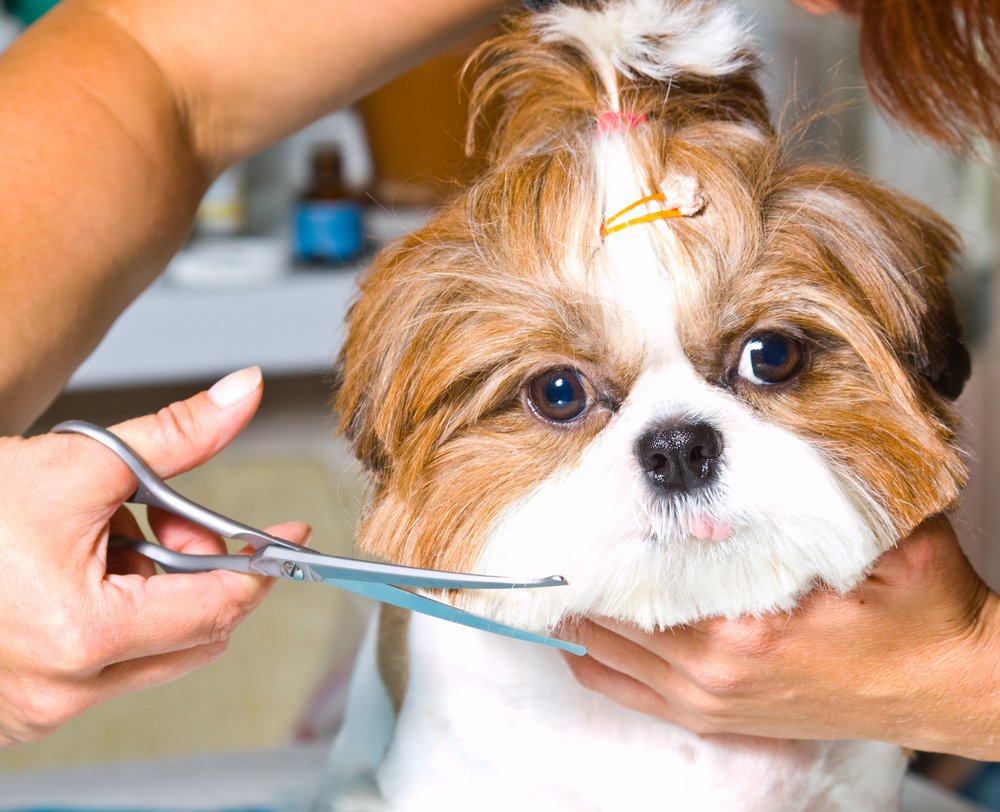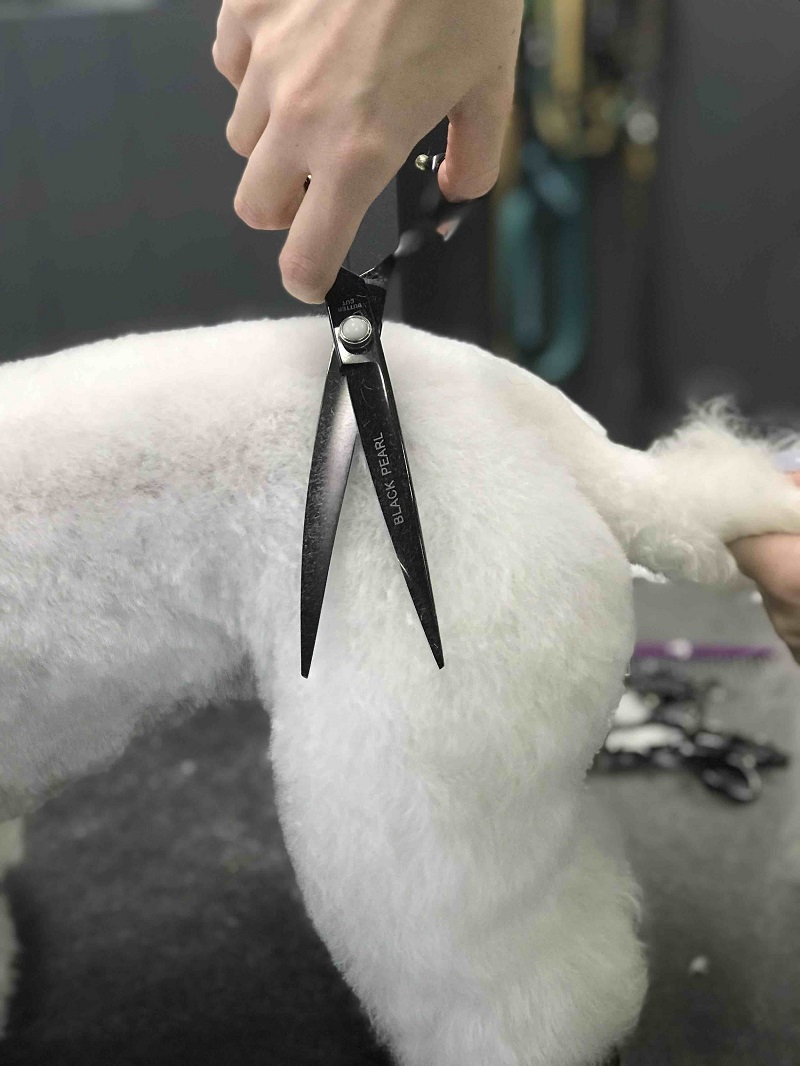 Scissors made for dog hair are different from paper or human hair scissors. They made to keep a sharp edge when dealing with dog hair. Human hair and paper scissors will blunt very quickly when used on dogs, as dog hair is much thicker than human hair. Human hair and dog hair, however, differ molecularly. When it comes to grooming our furry friends, it’s important to have the right tools for the job. Scissors are an essential tool in dog grooming, allowing us to achieve precise cuts and create beautifully styled coats.
Scissors made for dog hair are different from paper or human hair scissors. They made to keep a sharp edge when dealing with dog hair. Human hair and paper scissors will blunt very quickly when used on dogs, as dog hair is much thicker than human hair. Human hair and dog hair, however, differ molecularly. When it comes to grooming our furry friends, it’s important to have the right tools for the job. Scissors are an essential tool in dog grooming, allowing us to achieve precise cuts and create beautifully styled coats.
This guide helps you decide what scissor type, scissor length and scissor range best matches your needs. With a relaxed and cheerful tone, we’ll delve into the world of scissors, equipping you with the knowledge to make informed choices when it comes to grooming your beloved canine companion.
Blade Design and Length
The design and length of scissor blades vary between dog grooming scissors and human scissors. We’ll discuss the specific blade designs that are optimal for grooming dogs, such as straight blades, curved blades, and thinning shears. We’ll explore how these designs cater to the unique texture and thickness of a dog’s coat. Additionally, we’ll explain the importance of selecting the appropriate blade length for different grooming tasks, such as trimming, shaping, and blending. Understanding the nuances of blade design and length will empower you to make precise and effortless cuts.
Here are typical uses for each scissor length to help you decide:
- 4.5″ to 6.5″: Typically used for delicate or injury prone areas, such as face and feet, as well as toy breeds for body use. They give you the most precision. These shorter lengths are also available in safety-tip (or ‘ball tip’) scissors, which have rounded, blunt ends for extra protection from injury.
- 6.5″ to 7.5″: Still on the shorter side for more control and precision compared to longer scissors. The increased length makes them better for body work for toy and small breeds compared to scissors under 6.5″ which can get a bit fiddly (the very short lengths are better suited for face and feet work).
- 8” to 8.5”: The most popular ‘all rounder’ length for body work on all breeds, and for finishing. They may feel too long if you have toy or smaller breeds, or are less experienced.
- 9″ and longer: Although not as popular sellers, these longer lengths are valued by groomers for faster grooming times. Best saved for more experienced users.
Material and Durability
The materials used in the construction of dog grooming scissors differ from those of human scissors. We’ll explore the preferred materials for dog grooming scissors, such as stainless steel or Japanese steel. We’ll discuss the durability and sharpness of these materials, essential for withstanding the demands of grooming thick and sometimes matted dog coats. Additionally, we’ll provide tips on caring for and maintaining grooming scissors to ensure their longevity. By understanding the differences in material and durability, you’ll make investments that stand the test of time.
Choose your scissor type
The difference is the blade. A straight scissor has two, solid, straight blades. Curved scissors have two, solid, curved blades. Some straights and curved come with a safety tip (or ‘ball tip’) option, with a blunt end on the tip for delicate or injury prone areas.
Thinners, chunkers and blenders all have notched blades. Some thinners have two notched blades, but most have one solid blade and one notched blade. Thinners and blenders have thinner, smaller teeth, and smaller spaces between the teeth. Chunkers have wider spaces between the teeth, often with ‘T’ or ‘fishtail’ shaped teeth.
Straights are the easiest to get used to using as they are so similar to paper scissors. Curves tend to quickly become favourites once you get used to them, as almost no area of a dog’s body has straight lines. Curves help you get a smoother, more natural shape with less effort.
Blender-style thinners (that’s the type with one notched and one solid blade) are popular as finishing scissors, as they trim and tidy coat without leaving blunt lines. Often used to blend shorter areas in to long, tidy up any uneven areas or blend in clipper and blade marks to give your groom a polished, and professional look. They leave a smooth but textured finish, compared to the blunt cut a straight or curved scissor leaves. Thinners are also very popular for use on the face, as they help to achieve a softer, more natural look that many pet owners desire.
Safety Features
Safety should always be a top priority when grooming dogs. We’ll explore the safety features unique to dog grooming scissors, such as rounded tips and blunt ends. These features prevent accidental poking or cutting of sensitive areas, such as the face, ears, or paws. Additionally, we’ll discuss the importance of using scissors with a smooth cutting action and no sharp edges to minimize the risk of injury. By prioritizing safety, you can groom your dog with peace of mind.
Consider scissor level
Best sellers to groomers across all experience levels, and for home users (especially those frustrated that their cheaper scissors have become blunt so fast). This level includes the well-known Geib Gators and most of the Witte Roseline range. The latest Geib Gator 008 are a high-level 1 with the robustness of a level 1, but up a level in lightness and smoothness closer to a level 2. Level 1 scissors are dual-purpose.
Designed for beginners and grooming students, however also popular with experienced groomers who use level 1 scissors as their ‘workhorse’ shears, saving their level 2 and 3 scissors for finishing and more specialist applications. If you’re trying to get one scissor that ‘does it all’ the Gator (for beginners) and Gator 008 if ready to move up a level but not in need of a finishing scissor, are worth checking out in particular. Witte Roseline also make superb workhorse scissors and their thinners are a favourite for beginners.
Popular with students ready to move up a level, as well as experienced groomers who want a lighter, finer or overall higher-quality scissor. As well as being lighter, they tend to have a smoother action, and have a more ergonomic, offset handle, for less fatigue. They’ll often have longer blades with shorter shanks for more cut with less movement required. Some level 2 scissors are all-rounders, but most are intended for use after the initial block work or rough work is done using a level 1. Level 2 includes a wide range, from entry-level 2 Geib Entrée, up to the Geib Black Pearl which are a high-rated level 2 range.

When choosing scissors for dog grooming, it is important for the dog grooming to consider the specific coat type they will be working with. Scissors designed for human hair are not suitable for cutting a dog’s coat, as they are not sharp enough to cut through the coarser hair.
It is also true that using the wrong type of scissors for the different dog grooming tasks, can cause the blades to blunt prematurely and create undesired finishes especially on the new mixed poodle coats, terriers and mixed-texture, thick or double coats.
In summary, due to the difference in hair structure of humans and dogs, the techniques and scissors used to cut the hair types must be different. Using the correct dog grooming scissor for the right coat type is vital for a dog groomer.